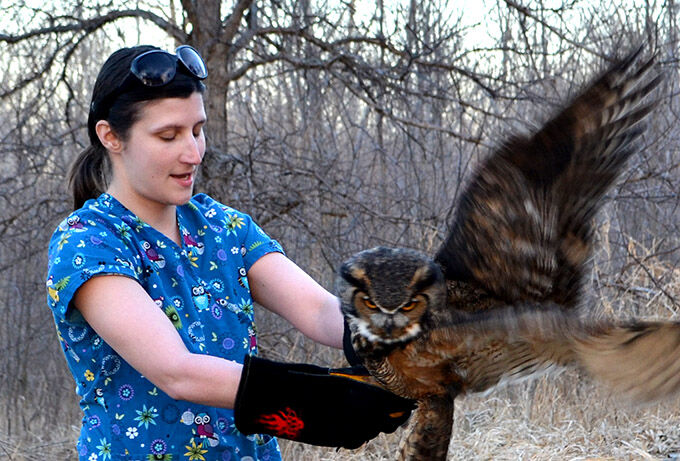By Joe Wilkinson
Special to the Economist
SOLON- It was January. A curious Labrador came within five feet of the scrawny, young owl. The terrified bird perched on a low branch, west of Solon, on public land. It didn’t move. The outlook was bleak.
Fast-forward six weeks. A small crowd walks through the trees to the same spot, near the Coralville Reservoir. With heavy duty gloves, Lacey Slutts reaches into the cardboard pet carrier she totes. From inside, drumming wingbeats indicate the occupant is more than ready to exit.
“She is a great horned owl; a ‘hatch year bird (from 2016),'” explained Slutts, a volunteer with Raptor Advocacy and Rehabilitation Education (RARE) of Iowa City. “When we picked her up (that day) she did have an eye injury (the right eye is still ‘pinkish’). She was skinny. She hadn’t been eating.”
But no bones were broken. There were no signs of disease. A few weeks of attention, adequate food and rehabilitation led to this moment. This top-of-the-line Iowa predator was ready for the wild.
With a flurry of frantic wingbeats and a boost from her human ally, the owl lifted off. For a moment, she seemed gigantic with her nearly four-foot wingspan. A few seconds later, she glided onto a treetop branch overlooking the reservoir. A minute later, headed east, looking for another secure perch.
Back in the human semi-circle, Greg Meyer grinned like a proud new dad- with good reason. He had stumbled upon the owl in January, while walking the dog. “It went from the ground, to the low branch. It didn’t move, even when Wes moved up close. Something was wrong,” recalled Meyer.
Leave the bird? Call someone? But whom? A few texts and phone calls led him to RARE. Within a couple hours, the young raptor was in a box, safe, and heading for a checkup, food? and shelter.
That stop included rehabilitation; careful monitoring as it swallowed down food provided by the non-profit organization. RARE works with facilities at Gentle Heart Pet Clinic in Iowa City, another spot along Highway 1 in Johnson County, and even a barn near Solon, for honing flight skills. Work at RARE because you want to do it. Everybody is a volunteer.
After more than six weeks, the young owl looked ready for the wild. “She has put on weight. When she came in, her keel score (a visual index of the muscle and fat along the breastbone) did not yield much hope. Now, she looks healthy. It is time to release her,” pronounced Slutts, as she gave the owl a toss to freedom.
Is the owl ruling the roost? Maybe. In the wild, most young animals don’t make it past the first year, like she has. Everything eats something? or is eaten by something else. But this bird had a second lease on life.
Just before sunset, eyes raise in my house as an owl wings past the picture window, 300 yards from the release site. Could it have been ‘Meyer’s bird,’ getting re-acquainted with its territory?
You want to say yes.
RARE Look March 18 in Iowa City
Get an up-close look at Raptor Advocacy and Rehabilitation Education (RARE) Saturday, March 18, from 10 a.m. to 2 p.m. The raptor rehabilitation group will feature a few birds- and an overview of its operation- at East Side Recycling Center, 2401 Scott Blvd. SE in Iowa City. Learn more about owls, hawks and other raptors in an education program. Take part in family friendly activities, too. Find out more at www.theraregroup.org.
Great horned owl released after rehab
February 22, 2017

